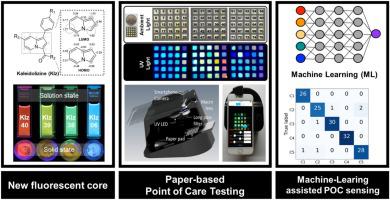Sensors and Actuators B: Chemical ( IF 8.0 ) Pub Date : 2020-12-01 , DOI: 10.1016/j.snb.2020.129248 Hyungi Kim 1 , Sang-Kee Choi 1 , Jungmo Ahn 2 , Hojeong Yu 3 , Kyoungha Min 3, 4 , Changgi Hong 5 , Ik-Soo Shin 6 , Sanghee Lee 7 , Hakho Lee 3, 8 , Hyungsoon Im 3, 8 , JeongGil Ko 9 , Eunha Kim 1, 5

|
Multiplexed analysis allows simultaneous measurements of multiple targets, improving the detection sensitivity and accuracy. However, highly multiplexed analysis has been challenging for point-of-care (POC) sensing, which requires a simple, portable, robust, and affordable detection system. In this work, we developed paper-based POC sensing arrays consisting of kaleidoscopic fluorescent compounds. Using an indolizine structure as a fluorescent core skeleton, named Kaleidolizine (KIz), a library of 75 different fluorescent KIz derivatives were designed and synthesized. These KIz derivatives are simultaneously excited by a single ultraviolet (UV) light source and emit diverse fluorescence colors and intensities. For multiplexed POC sensing system, fluorescent compounds array on cellulose paper was prepared and the pattern of fluorescence changes of KIz on array were specific to target chemicals adsorbed on that paper. Furthermore, we developed a machine-learning algorithm for automated, rapid analysis of color and intensity changes of individual sensing arrays. We showed that the paper sensor arrays could differentiate 35 different volatile organic compounds using a smartphone-based handheld detection system. Powered by the custom-developed machine-learning algorithm, we achieved the detection accuracy of 97 % in the VOC detection. The highly multiplexed paper sensor could have favorable applications for monitoring a broad-range of environmental toxins, heavy metals, explosives, pathogens.
中文翻译:

用于基于机器学习的即时化学传感的万花筒荧光阵列
多重分析允许同时测量多个目标,提高检测灵敏度和准确性。然而,高度多路复用分析对于床旁 (POC) 传感来说一直是一个挑战,因为它需要一个简单、便携、稳健且价格合理的检测系统。在这项工作中,我们开发了由万花筒荧光化合物组成的纸基 POC 传感阵列。使用中氮茚结构作为荧光核心骨架,命名为 Kaleidolizine (KIz),设计并合成了一个包含 75 种不同荧光 KIz 衍生物的文库。这些 KIz 衍生物同时被单个紫外 (UV) 光源激发并发出不同的荧光颜色和强度。对于多路 POC 传感系统,制备了纤维素纸上的荧光化合物阵列,阵列上 KIz 的荧光变化模式对吸附在该纸上的目标化学物质具有特异性。此外,我们开发了一种机器学习算法,用于自动、快速地分析单个传感阵列的颜色和强度变化。我们展示了纸质传感器阵列可以使用基于智能手机的手持检测系统区分 35 种不同的挥发性有机化合物。在定制开发的机器学习算法的支持下,我们在VOC检测中实现了97%的检测准确率。高度复用的纸质传感器可用于监测范围广泛的环境毒素、重金属、爆炸物、病原体。我们开发了一种机器学习算法,用于自动、快速地分析单个传感阵列的颜色和强度变化。我们展示了纸质传感器阵列可以使用基于智能手机的手持检测系统区分 35 种不同的挥发性有机化合物。在定制开发的机器学习算法的支持下,我们在VOC检测中实现了97%的检测准确率。高度复用的纸质传感器可用于监测范围广泛的环境毒素、重金属、爆炸物、病原体。我们开发了一种机器学习算法,用于自动、快速地分析单个传感阵列的颜色和强度变化。我们展示了纸质传感器阵列可以使用基于智能手机的手持检测系统区分 35 种不同的挥发性有机化合物。在定制开发的机器学习算法的支持下,我们在VOC检测中实现了97%的检测准确率。高度复用的纸质传感器可用于监测范围广泛的环境毒素、重金属、爆炸物、病原体。在定制开发的机器学习算法的支持下,我们在VOC检测中实现了97%的检测准确率。高度复用的纸质传感器可用于监测范围广泛的环境毒素、重金属、爆炸物、病原体。在定制开发的机器学习算法的支持下,我们在VOC检测中实现了97%的检测准确率。高度复用的纸质传感器可用于监测范围广泛的环境毒素、重金属、爆炸物、病原体。











































 京公网安备 11010802027423号
京公网安备 11010802027423号